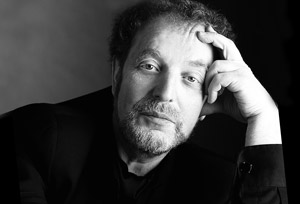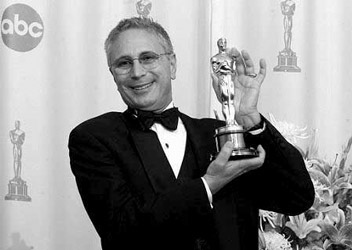Corigliano's Second Symphony: Raw Emotion by Lucie Renaud
/ April 3, 2003
Version française...
Yuli
Turovsky in conversation with Lucie Renaud
"My first encounter with John Corigliano's Second Symphony happened quite by chance. I learned
that the piece had won the Pulitzer Prize, a good indication of the quality of
the work and I was fascinated to discover how the piece holds itself
together.
 As a young composer, Corigliano
had stated that he would never write a symphony. He thought the genre was so
perfect, the repertoire so overwhelmingly rich that he felt the world did not
need a new symphony. As a young composer, Corigliano
had stated that he would never write a symphony. He thought the genre was so
perfect, the repertoire so overwhelmingly rich that he felt the world did not
need a new symphony.
Corigliano explained that for the First Symphony, he made an exception
because of tragic circumstances. Many of his friends had died from AIDS and he
was so distressed by his losses that he had to express his feelings about this
global tragedy with the most complex genre, the symphony. A few years later, he
got a commission from the Boston Symphony to write a symphony commemorating the
100th anniversary of the symphony hall. He proposed to write something else but
the orchestra insisted, so he decided to take a piece that he had written for
quartet, for a not so cheerful reason in his view. The Cleveland Quartet had
decided to disband after several decades together and they commissioned the work
for their last farewell tour. The First Symphony dealt with an avoidable
loss but the second deals more with a deliberate loss. Already, in the process
of composing that quartet, he felt that the emotional content and technical
challenges surpassed the boundaries of the genre, a little like the Grosse
Fuge by Beethoven. It is an almost
impossible task for a quartet to play that music.
Corigliano decided to base his Second Symphony on the same material
and started to find ways to expand it. That interested me especially because, as
you know, I Musici perform a lot of quartet literature transcribed for string
orchestra. When he toyed with ideas to use the colours of the symphony
orchestra, interestingly enough he thought the intensity of the work would be
diminished, even if, for example, the brass have a much wider range than the
strings. The impact of the strings is generated because they have to fight
to produce a more intensive sound than the pure
volume an orchestra could provide.
There are several different examples of composers who rewrote their own
quartets for the string orchestra. We can mention Schonberg's Transfigured
Night or his Second String Quartet, and some of Shostakovich's
quartets. Even the famous Andante Cantabile of Tchaikovsky's First
String Quartet was planned so that a string orchestra could perform it.
Composers do not necessarily exclude this way of thinking but you always find
some purists who get insulted when they hear of such transcriptions. When
we play Mahler's arrangement of Death and the Maiden, it becomes as much
Mahler as Schubert, because Mahler probably perceived it as his own. The same
thing happens with Corigliano's Second Symphony.
The symphony's structure is in five movements, reminiscent of the arch
structure of Bartok's Concerto for Orchestra. The first and fifth movements
are related, as well as the second and the fourth and the central movement deals
with music inspired by a stay in Morocco. The whole work is centred on tonal
points; the minor third plays an important role. The symphony starts and
finishes slowly; the second and fourth movements are quite energetic.
The first movement starts softly
and right away it creates an atmosphere. Each instrument comes in slightly out
of phase, forming a texture rather than a melodic pattern. Gradually, the notes
become longer and the minor third is featured for the first time. The musicians
are instructed to play whatever they want within this minor third. Of course,
Corigliano uses quartertones and three-quarter tones.
The second movement is a
scherzo, which also has some polyrhythmic effects. The whole orchestra plays at
a steady beat, but then the solo quartet suddenly starts to play much faster.
Most of the time, beats are not aligned and everybody, more or less, is
improvising the tempo. With the quartet, there were points where all four
members were supposed to meet but, of course, with an orchestra, everything has
to be written down. The freedom of the timing has to be fixed. I am sure it will
be a challenge for me to co-ordinate this section.
The fugue
follows the same idea. Corigliano was thinking of polyphony, not in the
traditional way. One instrument presents the theme, in a steady rhythm. Then the
second instrument imitates it with the same rhythm but at a completely different
speed, something very difficult to achieve for the conductor, who does not have
 enough arms! Instead,
he wrote it out on paper and shortened the length of each rhythm.
enough arms! Instead,
he wrote it out on paper and shortened the length of each rhythm.
The third movement is a Moroccan
reverie. The composer had gone to Morocco and he was waking up very early in the
morning because of the mosque's bells filling the air. All of them would ring at
the same time. At the end, the composer recalls that it was almost on the same
note. The central movement conveys that image, tries to recreate it. When he had
just the quartet at his disposal, he had to artificially create the feeling that
there are more than four voices. With the orchestra, it becomes a lot
easier.
What attracted me to the music
is that, despite all its modern inventions and traditions, it's emotionally
charged. It is not just a play of ideas, it is not cerebral, and it touches you
deeply. You feel the serenity of the Moroccan movement, the energy of the
scherzo with the interventions of the quartet, almost as if a rock band took
over the concert stage. I believe that the most important thing in music is the
message; you are touched by something and you feel the urge to share the
experience with others. This is the justification for composing and for
performing. When I feel the emotional charge, I know I want to work on a
particular piece. This symphony conveys intense action (and that is something I
really enjoy in music), powerful sonorities, interesting rhythms. It makes you
think, it makes you act and it makes you alive."
I Musici perform Corigliano's Second Symphony on April
10 at Pollack Hall. Info: (514) 398-4547
Version française... |
|


